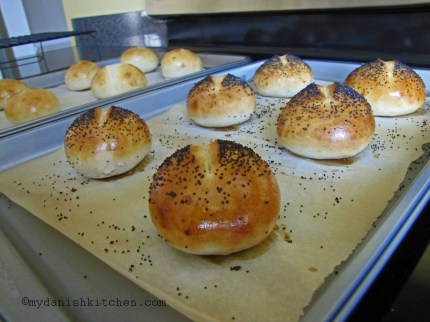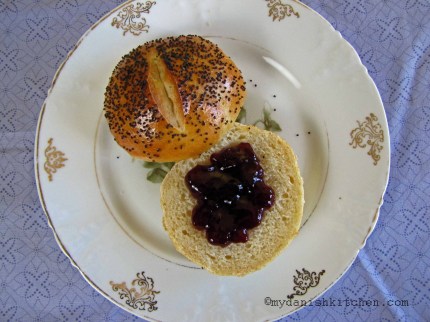
Danish Birkes
Up until the time I decided to make Birkes, I thought there was just one type of Birkes. But that is not the case at all. When I started researching recipes I discovered three different kinds of this super delicious Danish pastry.
I was born and raised in a part of Denmark called Jylland where the pastry is referred to as Birkes or Thebirkes. This Birkes does not have a Remonce filling and the pasty at our house was always sliced in half and topped with jam or cheese…super delicious! My search lead me further east to Sjælland which is the island where Copenhagen (København) is located. Here the pastry is called Københavnerbirkes or Thebirkes and the wonderful people in the Copenhagen area makes the pastry with a Remonce filling…equally wonderful in its own way. Grovbirkes, as far as I can tell, can be found throughout Denmark and it is made with a healthy portion of flaxseed, sesame seeds and/or sunflower seeds…this one I have never tasted.
My favorite is the Birkes without Remonce, I guess because it’s the one I grew up with. The Birkes is flaky and buttery in the best true Danish style. The Københavnerbirkes is sweeter in taste, and as far as I can tell, the pastry is eaten as-is. There is a lot of conversation going on out there in Cyber-land about Birkes vs Københavnerbirkes and I was surprised to find out that people from one end of the country to the other, is not really aware of the other kind of Birkes. When I called my parents to ask them about Birkes with a Remonce filling my mother said that she had never heard of “such a thing”, so apparently I am not the only one 🙂

Notice the clumps of butter in the two pictures on the right. The butter should be the size of kidney beans.

Rolling and folding process.

The dough is rolled out, then folded into thirds and folded into thirds again.
This process in repeated three times. Notice how you still see the butter in the dough.

Puff pastry (Butterdej) with all its wonderful layers!

If making Birkes with Remonce, spread remonce over 2/3 of dough, fold into thirds and cut into 2 inch rectangles.
Note: after I filled with Remonce, I placed the dough on the baking sheet upside down so the filling was towards the top. I think this may have resulted in the Birkes that had the filling in them, turned out like The Leaning Tower of Pisa. So try to place them on the baking sheet with the filling towards the bottom.
Makes 2 portions of Puff Pastry dough (Butterdej).
Ingredients:
For the dough:
3 1/2 cups flour (15 3/4 oz) (450 grams)
1 1/2 cups cold unsalted butter (12 oz) (340 grams)
4 1/2 teaspoons active dry yeast (or 50 grams cake/fresh yeast)
1/2 cup warm water (4 oz) (118 ml) (100 – 110 degrees Fahrenheit)
1/2 cup heavy cream (4 oz) (118 ml)
1/2 teaspoon cardamom
1/2 teaspoon salt
2 eggs, room temperature
1/4 cup sugar (1 3/4 oz) (55 grams)
For Remonce filling: optional
2.8 oz butter (80 grams) at room temperature
2.8 oz sugar (80 grams)
2.8 oz marzipan (80 grams) at room temperature
For final assembly:
1 egg, slightly beaten for brushing
Poppy Seeds for sprinkling
Directions:
Place flour into bowl of food processor with steel blade. Cut cold butter into 1/4 inch slices and add to flour. Pulse flour and butter until the butter is the size of kidney beans.
In a large bowl, dissolve the yeast in the warm water. Let stand 10 minutes. Stir in the cream, cardamom, salt, eggs and sugar and mix until combined using a fork. Using a rubber spatula, turn the flour/butter mixture into the liquid and carefully mix just until the dry ingredients are moistened. Cover and refrigerate for 4 hours, overnight or up to 4 days.
Turn the dough out onto a lightly floured surface, dust top of dough with flour. Roll out dough to make a 16 to 20 inch rectangle. Fold dough into thirds, rotate dough a quarter of turn and fold into thirds again, making a small square. Turn over dough. Repeat rolling and folding another two times (making it a total 3 times of rolling and folding), ending with a small square. Using a sharp knife cut dough into two halves. Wrap each 1/2 portion of dough in plastic wrap, place both dough portions in a plastic bag and chill for at least 30 minutes.
Refrigerated dough is now divided into 2 halves. Each half of dough will make 10 birkes rolls. If you are not using the second half of dough, it can be frozen for later use. Defrost in refrigerator for 24 plus hours before using.
If using the Remonce filling, make it at this time. Use a hand-held mixer, beat the butter, sugar and marzipan to a smooth soft spreadable cream. Set aside.
Remove first half of dough from refrigerator and place on a lightly floured surface, dust top of dough with flour. Roll dough out to a 12 x 18 inch rectangle. If using Remonce filling, spread a thin layer of the filling over 2/3 of the long edge of dough. Starting with the long edge that has the filling, fold 1/3 of dough over the middle. Then fold the remaining 1/3 of dough without filling over the middle, the dough is now folded into 3 layers. Using a sharp knife, cut dough into approximately 2 inch rectangular pieces. Place pieces of dough onto a baking sheet lined with parchment paper. Allow to rise for 20-30 minutes.
Preheat oven to 350 degrees F (180 degrees C). Lightly beat egg and brush onto top of dough. Sprinkle with poppy seeds. Bake for 15-20 minutes or until golden brown. Allow Birkes to cool on baking sheet. Birkes with Remonce filling is eaten as is. Birkes without filling is sliced in half and topped with jam or cheese. Enjoy
Source: My Danish Kitchen
This recipe will be submitted to YeastSpotting.

Read Full Post »


































